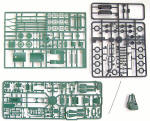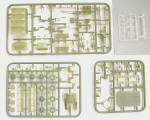|
KITS: |
Academy 1/72 US 2½
Ton 6x6 Cargo Truck
Airfix/Heller 1/72 GMC Truck
Hasegawa 1/72 GMC CCKW 353 Truck
PST 1/72 GMC CCW/CCKW 353 Cargo |
|
KIT #: |
? |
|
PRICE: |
$See review |
|
DECALS: |
several options |
|
REVIEWER: |
Peter Hobbins |
|
NOTES: |
Comparison review |
So often overlooked in
military history, logistics was a major contributor to the Allied victory
in WWII, whether it was Montgomery’s huge build-up of materiel prior to El
Alamein, the ‘Red Ball Express’ that supported the push out of Normandy, or
the mechanisation of Soviet troops that allowed them to exploit the
advances made by their armoured brigades. A key player in all of these
campaigns was the humble truck, especially the hundreds of thousands that
poured out of American factories throughout the war.
There is now a plethora of
1:72 US trucks on the market, especially the GMC CCKW for which no fewer
than four brands are available. But which one is the best? While not a
vehicle expert, I thought a comparative inbox review of all four might help
other modellers choose between the options. Please note that some of the
photos show sprues of slightly different versions from the boxtops (e.g. I
have the fire engine version of the PST kit), but the basic comments on
accuracy and buildability should nevertheless apply.

 The Hasegawa kit
is now quite long in the tooth and rather crude in places – especially the
chassis and suspension – or just plain wrong, such as the wheel hubs. There
are at least three options in the range, all soft-top varieties: a dump
truck, a fuel tanker and an open-back version with a canvas cover. These
kits might be OK for wargaming, given their simplicity and sturdiness, but
have been bypassed for detail and quality by the newer offerings.
The Hasegawa kit
is now quite long in the tooth and rather crude in places – especially the
chassis and suspension – or just plain wrong, such as the wheel hubs. There
are at least three options in the range, all soft-top varieties: a dump
truck, a fuel tanker and an open-back version with a canvas cover. These
kits might be OK for wargaming, given their simplicity and sturdiness, but
have been bypassed for detail and quality by the newer offerings.

 PST took an interesting
approach and kitted both the Studebaker US 6 and the GMC CCKW all from the
same basic set of sprues. While all represent the hard-top cab, this
approach means that each kit leaves the modeller with some excess parts,
plus specific sprues for the variant being modelled (including open-back
truck with canvas hood, fire engine, tanker and small arms repair shop
variants). The mouldings do a reasonable job of capturing the vehicle’s
shape and are well thought out – for instance, the tyres are all moulded
separate from the wheels, assisting with painting. A rudimentary engine is
provided but the cab doors are moulded shut, making interior detailing
difficult. The use of low-pressure injection moulding also means that there
is some loss of quality on the finer details such as tread patterns on the
running boards or the bars of the radiator grille and headlight guards,
leaving the modeller to buy aftermarket upgrade sets or scratchbuild such
details.
PST took an interesting
approach and kitted both the Studebaker US 6 and the GMC CCKW all from the
same basic set of sprues. While all represent the hard-top cab, this
approach means that each kit leaves the modeller with some excess parts,
plus specific sprues for the variant being modelled (including open-back
truck with canvas hood, fire engine, tanker and small arms repair shop
variants). The mouldings do a reasonable job of capturing the vehicle’s
shape and are well thought out – for instance, the tyres are all moulded
separate from the wheels, assisting with painting. A rudimentary engine is
provided but the cab doors are moulded shut, making interior detailing
difficult. The use of low-pressure injection moulding also means that there
is some loss of quality on the finer details such as tread patterns on the
running boards or the bars of the radiator grille and headlight guards,
leaving the modeller to buy aftermarket upgrade sets or scratchbuild such
details.

 Airfix/Heller
brought out a nice kit of the CCKW in 2004. This gives the modeller several
options within the one kit, including a choice of a soft tilt or
machine-gun mount (which is very nicely done), plus a canvas cover or open
back. The driver figure is poor and can be thrown away, but the overall
level of moulding is nice and the detail on pieces such as the wheels,
machine gun and suspension are good. However, I believe that the front
wheels are wrong – they should have six rather than five slots. This is
going to be almost impossible to correct without resorting to an
aftermarket replacement or raiding another kit (not the Hasegawa one – that
also has five slots!). It is clear some thought has been put into ejector
pin placement to minimise filling and filing problems, and the doors and
windscreen plus surround are moulded as single pieces in clear plastic to
minimise the likelihood of problems while gluing. The small decal sheet is
good and overall this seems a very buildable little kit.
Airfix/Heller
brought out a nice kit of the CCKW in 2004. This gives the modeller several
options within the one kit, including a choice of a soft tilt or
machine-gun mount (which is very nicely done), plus a canvas cover or open
back. The driver figure is poor and can be thrown away, but the overall
level of moulding is nice and the detail on pieces such as the wheels,
machine gun and suspension are good. However, I believe that the front
wheels are wrong – they should have six rather than five slots. This is
going to be almost impossible to correct without resorting to an
aftermarket replacement or raiding another kit (not the Hasegawa one – that
also has five slots!). It is clear some thought has been put into ejector
pin placement to minimise filling and filing problems, and the doors and
windscreen plus surround are moulded as single pieces in clear plastic to
minimise the likelihood of problems while gluing. The small decal sheet is
good and overall this seems a very buildable little kit.

 Have I saved the best
till last? Well, yes and no. The Academy kit was released in 2005
and offers even better detailing than the Airfix offering, both in terms of
the number of parts and the fineness of the mouldings. The tread patterns
on the running boards are beautifully done, as are the grab rails, side
boards and engine grille. This is a hard-top vehicle, but the modeller can
open a circular hole in the roof and install a machine-gun mount if
desired. However, no canvas hood is supplied for the tray. Of all four
kits, this is the only one to actually have open slots on all of the wheels
(the others have at least some that are solid), and while the doors are
attached to the cab sides, it will be much easier to cut them open than on
the PST kit. It also comes with a handy set of loads/diorama accessories,
including jerrycans, 44-gallon drums, ammo boxes and two each of .50 and
.30 calibre machine-guns, with both folded and deployed tripods – all very
useful for just about any US vehicle, soft-skin or otherwise. The decal
sheet looks good and allows for two options. On the downside, ejector pin
marks abound, and while some are hidden away or on inner surfaces, their
presence on places like the cab floor, tyres and machine-gun mount – to
name a few – means the modeller will have to pay close attention during
assembly to work out which need filing (and many will).
Have I saved the best
till last? Well, yes and no. The Academy kit was released in 2005
and offers even better detailing than the Airfix offering, both in terms of
the number of parts and the fineness of the mouldings. The tread patterns
on the running boards are beautifully done, as are the grab rails, side
boards and engine grille. This is a hard-top vehicle, but the modeller can
open a circular hole in the roof and install a machine-gun mount if
desired. However, no canvas hood is supplied for the tray. Of all four
kits, this is the only one to actually have open slots on all of the wheels
(the others have at least some that are solid), and while the doors are
attached to the cab sides, it will be much easier to cut them open than on
the PST kit. It also comes with a handy set of loads/diorama accessories,
including jerrycans, 44-gallon drums, ammo boxes and two each of .50 and
.30 calibre machine-guns, with both folded and deployed tripods – all very
useful for just about any US vehicle, soft-skin or otherwise. The decal
sheet looks good and allows for two options. On the downside, ejector pin
marks abound, and while some are hidden away or on inner surfaces, their
presence on places like the cab floor, tyres and machine-gun mount – to
name a few – means the modeller will have to pay close attention during
assembly to work out which need filing (and many will).
So which kit gets the
thumbs up? I think the Hasegawa offerings are now superseded, although
still quite suitable for younger modellers. The PST kits are OK but will
require more work than the mainstream releases, unless you want a specific
variant like the fire engine. Between the Airfix and Academy kits it’s a
bit of a draw, and may end up depending on whether you want a hard- or
soft-top cab. The Academy is the best-moulded of all four and comes with
some great extras, but will be fiddly to assemble, especially the ejector
pin marks. The Airfix kit probably offers more options within the one box,
and (at least in Australia) it’s about a third of the price of the Academy,
although the detail is not quite as sharp. For my purposes as an
unsophisticated vehicle modeller, my money falls just on the side of the
Airfix kit – not in the least because I really want to encourage Airfix to
keep coming out with new releases. Given that there are now four different
kits of this popular American truck, how about a mainstream kit of that
ubiquitous and pugnacious British lorry, the Canadian Pattern Chev ‘Blitz’?
October 2005
If you would like your product reviewed fairly and quickly by a
site that has around 300,000 visitors a month, please
contact
me or see other details in the
Note to
Contributors.
Back to the Main Page
Back to the Previews Index Page

 The Hasegawa kit
is now quite long in the tooth and rather crude in places – especially the
chassis and suspension – or just plain wrong, such as the wheel hubs. There
are at least three options in the range, all soft-top varieties: a dump
truck, a fuel tanker and an open-back version with a canvas cover. These
kits might be OK for wargaming, given their simplicity and sturdiness, but
have been bypassed for detail and quality by the newer offerings.
The Hasegawa kit
is now quite long in the tooth and rather crude in places – especially the
chassis and suspension – or just plain wrong, such as the wheel hubs. There
are at least three options in the range, all soft-top varieties: a dump
truck, a fuel tanker and an open-back version with a canvas cover. These
kits might be OK for wargaming, given their simplicity and sturdiness, but
have been bypassed for detail and quality by the newer offerings.




